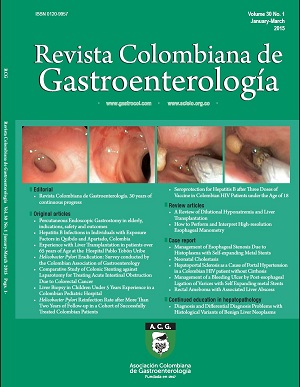Seroprotection for Hepatitis B after Three Doses of Vaccine in Colombian HIV Patients under the Age of 18
DOI:
https://doi.org/10.22516/25007440.23Keywords:
Hepatitis B, HIV infection, seroprotection, childrenAbstract
Introduction: Seroprotection against hepatitis B is defined as anti-hepatitis B surface antigen titer ≥ 10 IU/L), but in children with human immunodeficiency virus (HIV) this is low.
Objective: The objective of this study was to establish SP against HBV and potential associated factors in children with HIV in Cali, Colombia.
Methodology: This is a study of seroprotection against HBV in 85 children under 18 years of age after receiving three doses of vaccine. Clinical, paraclinical, environmental and sociodemographic variables were
considered. Statistical analysis included estimation of proportion per occurrence, 95% confidence intervals, percentages, means, standard deviations, and univariate analysis between variable exposure and effect.
Confounding factors were evaluated with 2x2 contingency tables and estimation of odds ratios with 95% confidence intervals. The Chi2 test was used with significance of p <0.05. The multivariate model used backward elimination. Variables with p> 0.10 were eliminated by likelihood-ratio test.
Results: SP was 35.3% (95% CI: 25.2 to 46.4, n = 30) in children with a mean age of 101 ± 44 months. Patients were predominantly female
gender and mixed race and had Stage C HIV (according to US Centers for Disease Control and Prevention (CDC) standards). Average treatment time was 5 years. No relationship was found between the time between
the first, second and third doses of vaccine and SP, nor among diagnosis, time of vaccination, and SP. The multivariate model showed an association of SP with the temporal relationship between start of treatment (0-3 years), last dose of vaccination (OR = 4.3, 95% CI: 0.96 to 19.23; p = 0.05) and more than three years after starting treatment (OR = 9.69, 95% CI: 2.37 to 39.5; p = 0.00).
Conclusion: The prevalence of SP was 35.3%, with a possible risk factor associated with the temporal relationship between onset of treatment and time of the last dose of vaccine.
Downloads
References
Broderick AL, Jonas MM. Hepatitis B in children. Semin Liver Dis 2003;23:59-68.
World Health Organization. Hepatitis B. 2010. Disponible en: URL http://www.who.int/mediacentre/factsheets/ fs204/en/ Consultada enero 31 de 2014.
Simani OE, Leroux-Roels G, Francois G, Burnett RJ, Meheus A, Mphahlele MJ. Reduced detection and levels of protective antibodies to hepatitis B vaccine in under 2-year- old HIV positive South African children at a paediatric out- patient clinic. Vaccine 2009;27:146-51.
Pessoa SD, Miyamoto M, Ono E, Gouvea A, De Moraes- Pinto MI, Succi R . Persistence of vaccine immunity against hepatitis B virus and response to revaccination in vertically HIV-infected adolescents on HAART. Vaccine 2010;28:1606-12.
Abzug MJ, Warshaw M, Rosenbllatt HM, Levin MJ, Nachman SA, Pelton SI, et al. Immunogenicity and immu- nologic memory after hepatitis B virus booster vaccination in HIV-infected children receiving highly active antiretrovi- ral therapy. J Infect Dis 2009;200:935-54.
Fernández-Ibieta M, Ramos JT, González-Tome MI, Guillén S, Navarro M, Cilleruelo MJ. Anticuerpos anti-VHB y VHA en niños y adolescentes con VIH. Enferm Infecc Microbiol Clin 2009;27:449-52.
Elisys Uno. Fully Automated ELISA Analizer. Microelisa. En: http://www.trendsandcompetence.com/userDown- loads/en/981230.pdf Consultada enero 31 de 2014.
Hoofnagle JH. Hepatitis B - preventable and now treatable. N Engl J Med 2006;354:1074-6.
Laurence JC. Hepatitis A and B immunizations of indivi- duals infected with human immunodeficiency virus. Am J Med 2005;118(10A):75S-83S.
Pippi F, Bracciale L, Stolzuoli L, Giaccherini R, Montomoli E, Gentile C, et al. Serological response to hepatitis B virus vaccine in HIV-infected children in Tanzania. HIV Med 2008;9:519-25.
Wilson CM, Ellenberg JH, Sawyer MK, Belzer M, Crowley- Nowick PA, Puga A, et al. Serologic response to hepatitis B vaccine in HIV infected and high risk HIV uninfected ado- lescents in the REACH cohort. Reaching for Excellence in Adolescent Care and Health. J Adolesc Health 2001;29(3 Suppl):123-9.
Siriaksorn S, Puthanakit T, Sirisanthana T, Sirisanthana V. Prevalence of protective antibody against hepatitis B virus in HIV-infected children with immune recovery after highly active antiretroviral therapy. Vaccine 2006;24:3095-9.
Washburn TC, Medearis DN, Childs B. Sex differences in susceptibility to infections. Pediatrics. 1965;35:57-64.
Velasco CA, López P, Contreras LJ. Anthropometric nutritional status in children HIV positive with vertical transmission. J Pediatr Gastroenterol Nutr 2005;41:508-9 (Abstract).
Velasco CA, Méndez F, López P. Cryptosporidiosis in
Colombian children with HIV/AIDS infection. Rev Colomb Med 2011;42:418-29.
Peters D. Diagnosis and management of hepatitis B virus
and HIV coinfection top. HIV Med 2007;15:163-6.
Padmapriyadarsini C, Pooranagangadevi N, Chandrasekaran K, Subramanyan S, Thiruvalluvan C, Bhavani PK, et al. Prevalence of underweight, stunting, and wasting among children infected with human immunodeficiency virus in South India. Internat J Pediatr 2009 Article ID 837627, 5 pages doi:10.1155/2009/837627.
Macallan DE. Wasting in HIV infection and AIDS. J Nutr
;129(Suppl 1):238-42.
Lepage P, Msellati P, Hitmana DG, Bazubagira A, van
Goethem C, Simonon A, et al. Growth of human immu- nodeficiency type I-infected and uninfected children: A prospective cohort study in Kigali, Rwanda, 1988 to 1993. Pediatr Infect Dis J 1996;15:479-85.
Myhre JA, Chadwick EG, Yogev R. Failure to thrive in HIV infected children: Incidence, prevalence, and clinical corre- lates. Pediatr AIDS HIV Infect 1997;7:83-90.
Pasricha N, Datta U, Chawla Y, et al. Immune responses in patients with HIV infection after vaccination with recombi- nant hepatitis B vaccine. BMC Infect Dis 2006;6:65.
Downloads
Published
How to Cite
Issue
Section
License
Aquellos autores/as que tengan publicaciones con esta revista, aceptan los términos siguientes:
Los autores/as ceden sus derechos de autor y garantizarán a la revista el derecho de primera publicación de su obra, el cuál estará simultáneamente sujeto a la Licencia de reconocimiento de Creative Commons que permite a terceros compartir la obra siempre que se indique su autor y su primera publicación en esta revista.
Los contenidos están protegidos bajo una licencia de Creative Commons Reconocimiento-NoComercial-SinObraDerivada 4.0 Internacional.




















